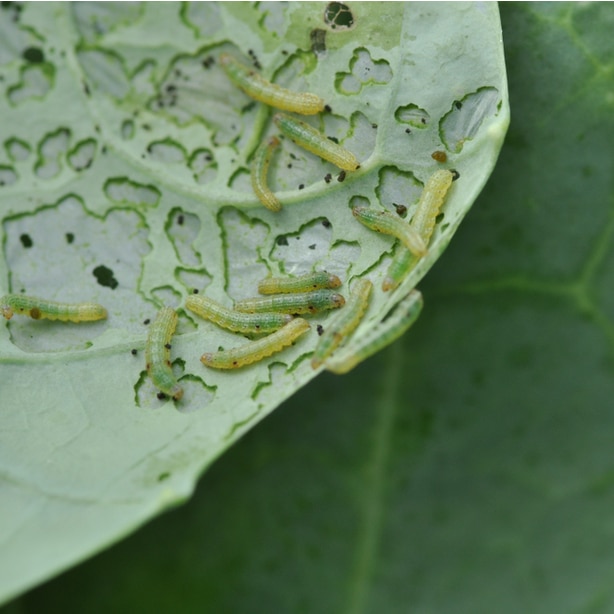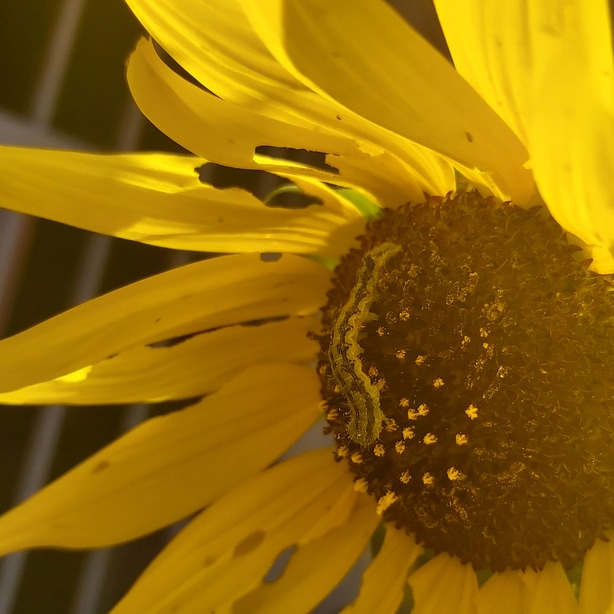Often described as wretched, repulsive, ugly, and just plain old unpleasant – cutworms don’t have looks going for them. These caterpillars live in the soil and come out at night to eat your tender seedlings and transplants. They can mow down an entire garden in one evening, cutting plants down right at the soil line.
You will probably not see them, but you will see their damage! Many times the top of the plant is wilting on the ground next to the chewed down stem. In fact, this is how these insects get their name – their ability to cut down plants as they feed on the stems.
Here’s what you need to know to combat these incredibly destructive garden pests.

Identification
“Cutworm” is a catch-all term for the larvae – caterpillars – of moths of the Noctuidae family. They are not true worms or grubs. There are 2500 species across North America.
These caterpillars are 1 to 2 inches long and are usually gray, brown, or black with spots or long stripes, depending on the species. Their most distinctive trait is how they curl into a C-shape when disturbed. Don’t confuse them with grubs, which are white (and create their own headaches).

The adults are gray, brown, or sooty colored moths that have paler hind wings. These moths are active at night and are attracted to light.
The most common and the most damaging species are the black, bristly, bronze, common or variegated, subgothic dart, reaper dart, and army cutworms. But whatever species they are, the damage is similar.
These pests are divided into four categories based on their feeding location:
- Climbing cutworms attack fruit, buds, and leaves.
- Tunnel makers chew off stems at the crown and topple young plants.
- Subterranean species feed on roots.
- Army worms attack on all fronts!

Damage: What They Do
Cutworms are often a problem in newly created gardens that had previously been lawn or uncultivated areas. They live in the soil and you might not see these caterpillars, but you can surely recognize the damage they cause. They usually attack at night but can come up to feed on cloudy days.
The most common damage we see is severed stems at or just below the soil line. For young seedlings and transplants, this means death.
What do they like to eat? Anything, really: Bedding plants and young perennials, turfgrass, beets, cabbage, broccoli, kale, cauliflower, tomatoes, corn, asparagus, beans, carrots, celery, lettuce, peas, and peppers…and more!
Some of them will destroy more plants than they can eat! And while some species have preferred foods, they will eat anything that they come across. Some will only eat a little bit of the plant they mowed down, which is even more frustrating.
As the summer progresses, the damage these insects cause lessens because natural enemies take their toll on the population.

Life Cycle
Larvae (and sometimes pupae) overwinter several inches below the soil line and wake up in mid-spring. This first generation is the hungriest and does the most damage.
After a few weeks, the caterpillars pupate in the soil. The pupae are shiny brown and are about 1-½ long. If you find them while digging in your garden, destroy them.
Adults emerge in early summer, mate, and then the females lay round, white eggs on the soil or plants and plant debris.
After the larvae hatch, they live underground, coming out at night to dine on your garden.
Black cutworms complete their life cycle in 30 to 40 days. That means there can be several generations in a growing season. The last generation overwinters in the soil.

Control
The best control is prevention. These caterpillars can do an enormous amount of damage in a very short amount of time. The best controls keep them out of your garden and away from your plants.
The first step in controlling them entails detection and identification. Feeding damage can be confused with rabbit damage. Rabbits bite on a diagonal, and the cut is very clean-looking as if someone used clippers on the plant. Cutworm damage has a more chewed appearance and many times, the chewed-off portion is lying on the ground.
A test can be conducted to determine the presence and number of these pests—Mark off a square yard containing both damaged and healthy plants. Use one tablespoon of garden insecticide containing 1-2% pyrethrins in a gallon of water. Apply to the area uniformly with a sprinkling can. In no time, you’ll see them come up to the surface!
10 Cultural Control Tips to Prevent damage

- Remove weeds in the fall and early spring. This denies the adults a place to lay eggs and denies the young larvae food. The only downside to this is that by removing weeds, you are leaving just one food source – your desired crop!
- Till your garden before you plant. This will chop up the overwintering larvae and expose them to predators. If you have chickens, let them loose in the tilled garden to gobble up these pests.
- Plant later in the season. You can starve that first-generation if you wait to plant until late spring or early summer.
- Plant big plants. These caterpillars love the tender, new stems of small transplants and seedlings. Bigger plants are less inviting to them.
- Create a barrier. Collars made from paper towel tubes can be placed around each new plant. Cut lengths about 5 inches long and cut a slit up one side. Circle the plant’s stem with the cardboard and push the tube about 2 inches into the soil. The insects will not be able to breach this barrier. You can also make barriers from aluminum foil, tin cans, or newspaper.
- Cutworms need to completely encircle a stem in order to chomp it off. If you place a large nail or a wooden stick right up against the stem, the caterpillars will not be able to do this.
- The adult moths are attracted to light and heavy infestations have been noted in areas that are illuminated at night. So turn off the outside lights around your garden.
- Keep the lawn around your garden cut short to deny females a place to lay eggs.
- Remove debris and keep the garden on the dry side. Cutworms prefer cool, shady, damp places. They hide from predators in garden debris
- Create a “buffer zone” of dry soil between your garden and the lawn or any uncultivated areas. They don’t like to cross dry soil.
Mechanical Controls
Go out at night with a flashlight and a bucket of soapy water and, wearing gloves, handpick the caterpillars and drop them into the bucket. We admit: this is in the top ten of the grossest garden chores.
Spread a mixture of sawdust and wheat bran mixed with water and molasses around the base of the plants. Cutworms will be drawn in by their love of molasses and they can’t digest the sawdust or bran. The molasses hardens on their bodies and immobilizes them.

Sunflowers can be used as a trap crop, but the caterpillars will still need to be picked off the sunflowers. Because once they finish off the sunflowers, they will move on to your other plants.
Tansy has been known to repel them. You can plant tansy around your garden as a barrier.
Crushed eggshells, coffee grounds, and diatomaceous earth (DE) all feel unpleasant to them as they crawl along the soil. You can sprinkle these deterrents around your plants.
Biological Controls
Thankfully, these pests have many natural enemies. There are at least 15 species of bacteria, viruses, and protozoans that specifically target black cutworms. Swallows and bats dine on the moths, and the larvae are tasty to many birds, toads, moles, shrews, and snakes. Therefore, strive to create a garden that is rich in biodiversity!
Trichogramma wasps, bacillus thuringiensis (Bt), beneficial nematodes, and diatomaceous earth (DE) can also be used to control these pests. These can be purchased at garden centers or online. Follow the directions carefully.
Chemical Controls
If you’re thinking about using a pesticide, it’s best to use it when this pest is the most vulnerable – that’s the larva stage. Eggs, adults, and pupae are invulnerable to pesticides.
Be sure that the pesticide you are using is labeled for use on cutworms and follow the directions. Keep in mind, however, that pesticide use is often unsuccessful when battling these repulsive garden pests. It’s best to try preventative measures first and to be prepared next year.



